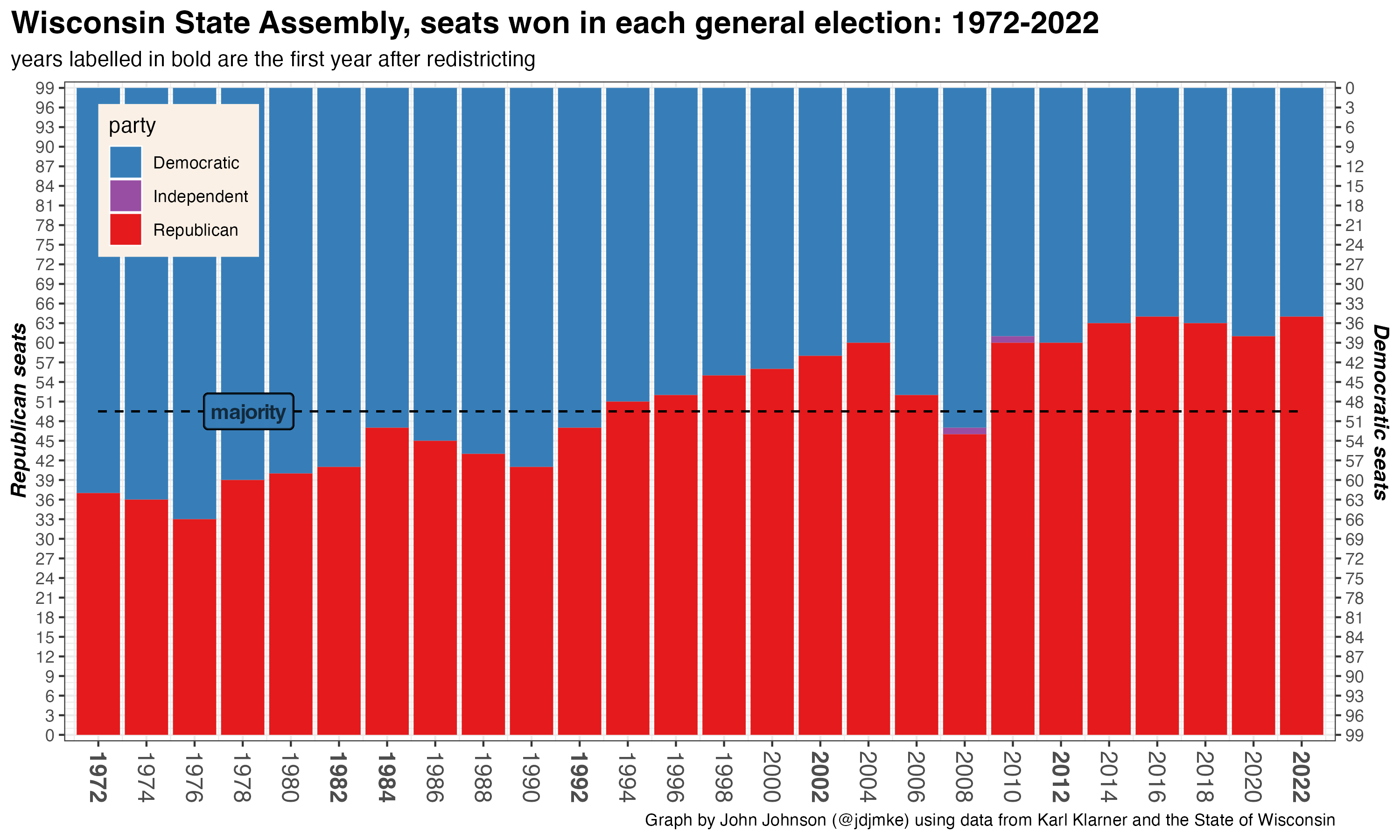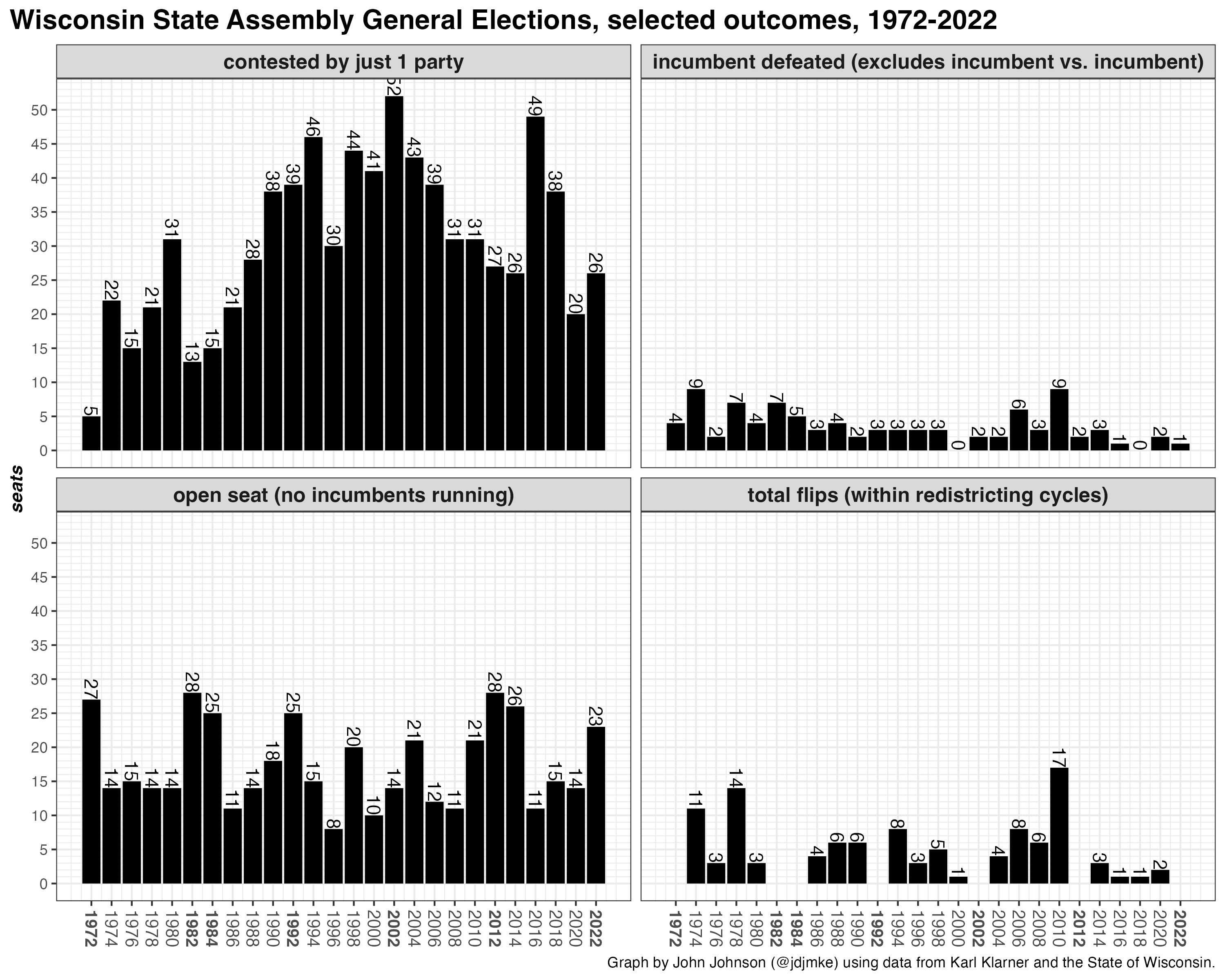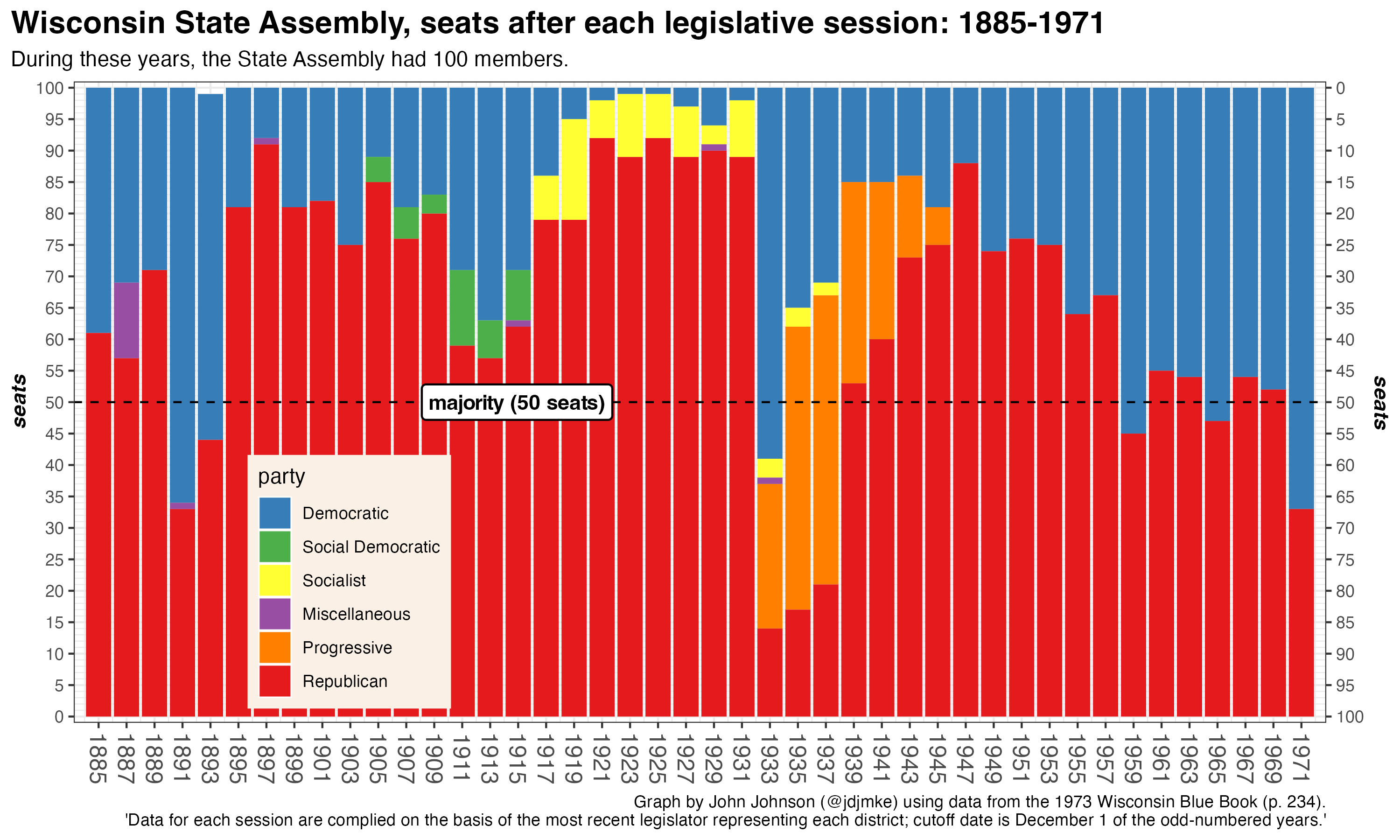Wisconsin Governor 2026 Outlook
Gov. Tony Evers announced July 24 that he will not seek a third term in 2026.
Evers has been the most consistently popular state politician in Wisconsin since his election in 2018. He has maintained an average approval rating above 50%, with disapproval averaging 41%. He is also better known and better liked than most other office holders in the state.
With Evers out of the race all the candidates in both the Democratic and Republican primaries will begin with very low name recognition and will need substantial campaign resources to introduce themselves to voters statewide.
A majority of registered voters in the June 2025 Marquette Law School poll said they would not like Evers to seek a third term, though over 80% of Democrats wanted him to run.
Should Evers run? (June 2025 MULawPoll)
Would you personally like to see Tony Evers seek a third term as governor in 2026?
| Poll dates | Yes | No | Don’t know | Refused | n |
|---|---|---|---|---|---|
| 6/13-19/25 | 42 | 55 | 2 | 1 | 873 |
Evers retains strong support for a third term with Democratic voters, 83% of whom support a third term bid, but 50% of independents oppose a third term as do a very large majority of Republicans.
| Party ID | Yes | No | Don’t know | Refused | n |
|---|---|---|---|---|---|
| Republican | 7 | 93 | 0 | 0 | 398 |
| Independent | 37 | 50 | 9 | 4 | 106 |
| Democrat | 83 | 15 | 1 | 1 | 363 |
Evers job approval history
Overall, do you approve or disapprove of the way Tony Evers is handling his job as Governor of Wisconsin?
| Poll dates | Net | Approve | Disapprove | Don’t know | Refused | n |
|---|---|---|---|---|---|---|
| 1/16-20/19 | 17 | 39 | 22 | 38 | 1 | 800 |
| 4/3-7/19 | 10 | 47 | 37 | 15 | 0 | 800 |
| 8/25-29/19 | 20 | 54 | 34 | 10 | 1 | 800 |
| 10/13-17/19 | 18 | 52 | 34 | 13 | 1 | 799 |
| 11/13-17/19 | 5 | 47 | 42 | 10 | 1 | 801 |
| 12/3-8/19 | 12 | 50 | 38 | 11 | 1 | 800 |
| 1/8-12/20 | 11 | 51 | 40 | 9 | 0 | 800 |
| 2/19-23/20 | 13 | 51 | 38 | 10 | 1 | 1000 |
| 3/24-29/20 | 36 | 65 | 29 | 6 | 1 | 813 |
| 5/3-7/20 | 26 | 59 | 33 | 7 | 1 | 811 |
| 6/14-18/20 | 16 | 54 | 38 | 6 | 1 | 805 |
| 8/4-9/20 | 20 | 57 | 37 | 6 | 0 | 801 |
| 8/30-9/3/20 | 8 | 51 | 43 | 5 | 2 | 802 |
| 9/30-10/4/20 | 10 | 52 | 42 | 5 | 1 | 805 |
| 10/21-25/20 | 7 | 50 | 43 | 7 | 0 | 806 |
| 8/3-8/21 | 7 | 50 | 43 | 7 | 0 | 807 |
| 10/26-31/21 | -1 | 45 | 46 | 8 | 1 | 805 |
| 2/22-27/22 | 9 | 50 | 41 | 8 | 1 | 802 |
| 4/19-24/22 | 6 | 49 | 43 | 7 | 1 | 805 |
| 6/14-20/22 | 3 | 48 | 45 | 6 | 1 | 803 |
| 8/10-15/22 | 2 | 47 | 45 | 8 | 1 | 811 |
| 9/6-11/22 | -3 | 44 | 47 | 8 | 0 | 801 |
| 10/3-9/22 | -2 | 46 | 48 | 5 | 1 | 801 |
| 10/24-11/1/22 | -1 | 46 | 47 | 6 | 2 | 802 |
| 6/8-13/23 | 18 | 57 | 39 | 4 | 0 | 913 |
| 10/26-11/2/23 | 7 | 53 | 46 | 2 | 0 | 908 |
| 1/24-31/24 | 7 | 51 | 44 | 5 | 0 | 930 |
| 4/3-10/24 | 8 | 52 | 44 | 3 | 0 | 814 |
| 6/12-20/24 | 7 | 51 | 44 | 6 | 0 | 871 |
| 7/24-8/1/24 | 7 | 51 | 44 | 5 | 0 | 877 |
| 8/28-9/5/24 | 7 | 51 | 44 | 5 | 0 | 822 |
| 9/18-26/24 | 2 | 48 | 46 | 5 | 0 | 882 |
| 10/16-24/24 | 6 | 51 | 45 | 4 | 0 | 834 |
| 2/19-26/25 | 5 | 49 | 44 | 6 | 0 | 864 |
| 6/13-19/25 | 2 | 48 | 46 | 5 | 0 | 873 |
Average approval: 50.4% Average disapproval: 41.2%
Number of poll with positive and negative net approval:
Net postive approval: 31 of 35 polls.
Net negative approval: 4 of 35 polls.
Approval by year
| Year | Net | Approve | Disapprove | Don’t know | Refused | n |
|---|---|---|---|---|---|---|
| 2019 | 13 | 48 | 35 | 16 | 1 | 4800 |
| 2020 | 16 | 54 | 38 | 7 | 1 | 7443 |
| 2021 | 2 | 47 | 45 | 7 | 1 | 1612 |
| 2022 | 2 | 47 | 45 | 7 | 1 | 5625 |
| 2023 | 13 | 55 | 42 | 3 | 0 | 1821 |
| 2024 | 7 | 51 | 44 | 5 | 0 | 6030 |
| 2025 | 4 | 49 | 45 | 6 | 0 | 1737 |
Evers favorability
[Tony Evers] Do you have a favorable or unfavorable opinion of <> or haven’t you heard enough about them yet?
| Poll dates | Net | Favorable | Unfavorable | Not heard+DK | Haven’t heard enough | Don’t know | n |
|---|---|---|---|---|---|---|---|
| 2/25-3/1/18 | 7 | 20 | 13 | 66 | 48 | 18 | 800 |
| 6/13-17/18 | 5 | 22 | 17 | 61 | 45 | 16 | 800 |
| 7/11-15/18 | 11 | 25 | 14 | 60 | 46 | 14 | 800 |
| 8/15-19/18 | 8 | 31 | 23 | 45 | 37 | 9 | 800 |
| 9/12-16/18 | 9 | 35 | 26 | 39 | 29 | 10 | 800 |
| 10/3-7/18 | 3 | 38 | 35 | 27 | 22 | 5 | 1000 |
| 10/24-28/18 | 0 | 38 | 38 | 24 | 18 | 5 | 1400 |
| 1/16-20/19 | 17 | 41 | 24 | 34 | 28 | 6 | 800 |
| 4/3-7/19 | 13 | 48 | 35 | 17 | 12 | 5 | 800 |
| 8/25-29/19 | 14 | 49 | 35 | 16 | 11 | 5 | 800 |
| 10/13-17/19 | 12 | 47 | 35 | 18 | 13 | 5 | 799 |
| 11/13-17/19 | 2 | 43 | 41 | 15 | 12 | 3 | 801 |
| 12/3-8/19 | 8 | 45 | 37 | 17 | 12 | 5 | 800 |
| 1/8-12/20 | 8 | 45 | 37 | 17 | 14 | 3 | 800 |
| 2/19-23/20 | 3 | 43 | 40 | 16 | 12 | 4 | 1000 |
| 3/24-29/20 | 26 | 54 | 28 | 17 | 11 | 6 | 813 |
| 5/3-7/20 | 14 | 50 | 36 | 13 | 7 | 5 | 811 |
| 6/14-18/20 | 17 | 54 | 37 | 9 | 7 | 2 | 805 |
| 8/4-9/20 | 17 | 52 | 35 | 13 | 9 | 4 | 801 |
| 8/30-9/3/20 | 6 | 47 | 41 | 11 | 9 | 2 | 802 |
| 9/30-10/4/20 | 7 | 47 | 40 | 12 | 9 | 3 | 805 |
| 10/21-25/20 | 4 | 47 | 43 | 10 | 8 | 2 | 806 |
| 8/3-8/21 | 4 | 46 | 42 | 11 | 8 | 3 | 807 |
| 10/26-31/21 | -3 | 42 | 45 | 12 | 9 | 4 | 805 |
| 2/22-27/22 | 6 | 47 | 41 | 11 | 7 | 4 | 802 |
| 4/19-24/22 | 5 | 47 | 42 | 10 | 7 | 3 | 805 |
| 6/14-20/22 | 2 | 44 | 42 | 14 | 11 | 2 | 803 |
| 8/10-15/22 | 5 | 46 | 41 | 12 | 6 | 6 | 811 |
| 9/6-11/22 | 0 | 45 | 45 | 10 | 7 | 3 | 801 |
| 10/3-9/22 | -2 | 44 | 46 | 9 | 6 | 3 | 801 |
| 10/24-11/1/22 | -2 | 44 | 46 | 9 | 6 | 3 | 802 |
| 6/8-13/23 | 13 | 52 | 39 | 9 | 8 | 1 | 913 |
| 10/26-11/2/23 | 8 | 50 | 42 | 8 | 7 | 1 | 908 |
| 1/24-31/24 | 7 | 52 | 45 | 3 | 3 | 0 | 930 |
| 4/3-10/24 | 5 | 50 | 45 | 5 | 5 | 0 | 814 |
| 6/12-20/24 | 8 | 51 | 43 | 6 | 6 | 0 | 871 |
| 7/24-8/1/24 | 9 | 50 | 41 | 9 | 9 | 0 | 877 |
| 8/28-9/5/24 | 6 | 49 | 43 | 8 | 8 | 0 | 822 |
| 9/18-26/24 | 9 | 51 | 42 | 7 | 6 | 0 | 882 |
| 10/16-24/24 | 5 | 49 | 44 | 7 | 7 | 0 | 834 |
| 2/19-26/25 | 0 | 47 | 47 | 7 | 6 | 0 | 864 |
| 6/13-19/25 | -2 | 45 | 47 | 8 | 8 | 0 | 873 |
Evers favorability by year
| Year | Net | Favorable | Unfavorable | Not heard+DK | Haven’t heard enough | Don’t know | n |
|---|---|---|---|---|---|---|---|
| 2018 | 6 | 31 | 25 | 43 | 33 | 10 | 6400 |
| 2019 | 12 | 46 | 34 | 20 | 15 | 5 | 4800 |
| 2020 | 11 | 49 | 38 | 13 | 10 | 4 | 7443 |
| 2021 | 0 | 44 | 44 | 12 | 8 | 4 | 1612 |
| 2022 | 3 | 46 | 43 | 11 | 7 | 4 | 5625 |
| 2023 | 10 | 51 | 41 | 8 | 7 | 1 | 1821 |
| 2024 | 7 | 50 | 43 | 6 | 6 | 0 | 6030 |
| 2025 | -1 | 46 | 47 | 8 | 7 | 0 | 1737 |
Building name familiarity
Evers is now far better known than any of the potential Democratic or Republican candidates. His absence from the race levels the playing field with all candidates having to take time to build recognition. While candidates may be well known locally in their city or district, creating statewide name recognition requires extensive campaigning.
In February 2018, Evers was unknown to 66% of registered voters (who said they either hadn’t heard enough or didn’t know if they had a favorable or unfavorable opinion of him.) Even by July 2018 he was still unfamiliar to 60%. This is typical of non-incumbent candidates who must introduce themselves to voters statewide.
For comparison, in February 2022 Rebecca Kleefisch, after serving 8 years as Lt. Governor, was unfamiliar to 50%. In January 2019, following his election as Attorney General, Josh Kaul was not familiar to 77%. In June 2023, U.S. Representative Tom Tiffany was unfamiliar to 75%.



